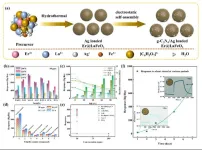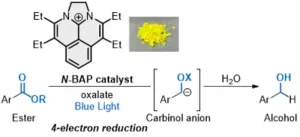(Press-News.org) Atlanta, Ga.—Eczema, a skin inflammatory disease that causes dry, itchy and inflamed skin, affects millions worldwide. Eczema is associated with an altered skin microbiome and higher colonization by Staphylococcus aureus. The study, led at New York Medical by postdoctoral fellow Anish R. Maskey, Ph.D., focuses on the natural compound berberine and its impact on eczema exacerbated by S. aureus. The findings, presented at ASM Microbe, shed light on berberine’s ability to inhibit S. aureus colonization and alleviate eczema symptoms without adverse effects.
Current treatments often fall short—topical antibiotics can give temporary relief, but risk development of antibiotic resistance, and steroid use can potentially result in topical steroid withdrawal (TSW) syndrome. This study makes significant strides toward more effective eczema management using berberine.
The research team conducted comprehensive analyses, including whole genome sequencing of isolated S. aureus strains from eczema patients. The results revealed resistance genes and toxin-encoding genes, underscoring the urgency for alternative treatments. Berberine showed anti-inflammatory effects and inhibited mast cell degranulation, a key mechanism in eczema progression, suggesting its potential as a therapeutic agent. Mechanistic insights uncovered berberine’s ability to suppress genes associated with inflammatory pathways, and computational modeling identified key targets in the PI3K/AKT pathways.
"Berberine may be a valuable natural product for treatment of multi-drug resistant S. aureus-exacerbated eczema due to its antibacterial and anti-inflammatory [effects] and inhibition of mast cell degranulation,” Maskey said.
Funding from The Lie and Artati Family Fund and the Study of Integrative Medicine Fund supported this research.
###
ASM Microbe is the annual meeting of the American Society for Microbiology, held June 13-17, 2024, in Atlanta, Ga.
The American Society for Microbiology is one of the largest professional societies dedicated to the life sciences and is composed of 36,000 scientists and health practitioners. ASM's mission is to promote and advance the microbial sciences.
ASM advances the microbial sciences through conferences, publications, certifications, educational opportunities and advocacy efforts. It enhances laboratory capacity around the globe through training and resources. It provides a network for scientists in academia, industry and clinical settings. Additionally, ASM promotes a deeper understanding of the microbial sciences to diverse audiences.
END
Berberine could treat eczema-exacerbated staph infections
2024-06-16
ELSE PRESS RELEASES FROM THIS DATE:
NIH-funded intervention did not impact opioid-related overdose death rates over evaluation period
2024-06-16
A data-driven intervention that engaged communities to rapidly deploy evidence-based practices to reduce opioid-related overdose deaths – such as increasing naloxone distribution and enhancing access to medication for opioid use disorder – did not result in a statistically significant reduction in opioid-related overdose death rates during the evaluation period, according to results from the National Institutes of Health’s HEALing (Helping to End Addiction Long-Term) Communities Study. Researchers identified the COVID-19 pandemic and increased prevalence ...
Protein-rich diets may influence gut microbiome and body composition
2024-06-15
Atlanta, GA – New research has shed light on the effects of protein-rich diets on the gut microbiome and overall health. Despite the increasing protein intake in Western diets, especially among athletes and individuals with obesity, the fate of undigested protein and its impact on human health remains largely unknown. A new study, presented at ASM Microbe, explores how excess undigested protein in the colon can be fermented to produce beneficial metabolites, such as short-chain fatty acids (SCFAs), or lead to the production of harmful metabolites like ammonia and sulfides, which are linked to gastrointestinal disorders and other health issues.
The research team conducted a series of experiments ...
Sulfur metabolites linked to neurodegenerative diseases
2024-06-15
Highlights:
Mouse studies suggest a link between the gut microbiome and neurodegenerative diseases, but the pathways remain unclear.
New study reports distinct bacterial and metabolite profile in patients with Alzheimer’s disease and other neurodegenerative diseases.
The study flagged the metabolite DHPS as a possible missing link in our understanding of how gut microbes influence NDDs through sulfur metabolism pathways.
Atlanta, Ga.—Neurodegenerative diseases (NDDs), which have no known cures and elusive causes, result in irreversible damage to the brain and nervous system. Research into these diseases typically focuses on the brain, but mouse ...
Insights into the salivary glands
2024-06-15
TLS are accumulations of lymphoid cells that share similar cellular compartments, organization, and function as secondary lymphoid organs. Importantly, the presence of these structures in inflamed salivary glands associated with active disease, increased autoantibody production, and malignancy risk.
“To treat patients effectively, comprehensive understanding of the salivary gland microenvironment is needed”, said Saba Nayar, “but current profiling efforts often struggle to capture high-plex 'omics data while preserving the spatial architecture of the tissue.”
To ...
Holistic approach to care
2024-06-15
The 16-week Plants for Joints trial investigated the effects of a multidisciplinary lifestyle intervention in people with RA, as compared to usual care. The intervention was based on a whole-food, plant-based diet – alongside physical activity and stress management. Previous reports showed this intervention significantly reduced the 28-joint disease activity score (DAS28) compared to usual care alone.2,3 To expand on this, the researchers wanted to determine the long-term effectiveness of the intervention, specifically with ...
Ultra-high sensitivity for isoamyl alcohol based on g-C3N4 nanosheets incorporated Ag nanoparticles loaded Er0.05La0.95FeO3 heterojunctions with enhanced moisture resistance
2024-06-15
The volatile of isoamyl alcohol released from the stored wheat increased with the storage extending, making it one of the potential biomarkers for the early-stage of wheat mildew. Currently, there is a scarcity of chemiresistors for isoamyl alcohol detection, which suffer from low sensitivity. The team of material scientists led by Professor Chao Zhang reported that LaFeO3-based sensing materials demonstrated remarkable sensitivity for isoamyl alcohol (DOI: 10.1039/D3TA05718F, 10.1007/s11666-024-01740-4). However, it’s essential to note that there is still potential for lowering the optimal operating temperature and enhancing moisture ...
Reduction of esters by a novel photocatalyst
2024-06-15
The sweet smell of strawberries and other fruits is thanks to a chemical compound called ester, which is also found in many fats and polyesters. The ubiquitous compound can be broken down to produce desirable alcohols and other chemicals for use across industries including pharmaceuticals and cosmetics, but the process can be costly, both financially and in terms of the environment.
Now, a team of researchers with the National Institutes of Natural Sciences (NINS) in Japan has developed a novel approach using light as an energy ...
Is there a link between increased headaches and hotter temperatures for individuals with migraines?
2024-06-15
As temperatures rise, so do chances for migraine attacks, according to a new study from a team of researchers at the University of Cincinnati College of Medicine, Icahn School of Medicine at Mount Sinai, Errex Inc. and Teva Pharmaceuticals USA. Inc.
“Weather change is one of the most common trigger factors for migraine,” says Vincent Martin, MD, director of the Headache and Facial Pain Center at UC's Gardner Neuroscience Institute and UC Health physician. He is the study’s lead author and president of the National Headache Foundation.
These findings from the study, which looked at use of Fremanezumab and whether it could prevent headaches ...
When bacteria are buckling
2024-06-15
Cyanobacteria are one of the oldest and most important life forms in the world – for example as they took an essential part in producing the oxygen in our atmosphere. Some types form long filaments composed of a few to more than 1,000 individual cells. In this form, the filamentous bacteria can move around. The principles of this locomotion have now been investigated by a research team led by Stefan Karpitschka, group leader at the MPI-DS and professor at the University of Konstanz, in collaboration with the University of Bayreuth and the University of Göttingen.
"We measured the force during locomotion on individual ...
In brief: Multi-omics analysis identifies molecularly defined Alzheimer’s disease subtypes
2024-06-15
Omics analysis is the process of analyzing large data sets to extract meaningful information about biological molecules—genes, DNA, RNA, proteins, metabolites or more—with the goal of illuminating typical molecular pathways and deciphering where things go awry in disease. In a study led by Bruno A. Benitez, MD, a human geneticist and director of the Neurobiorepository in the department of Neurology at Beth Israel Deaconess Medical Center (BIDMC), investigators used machine learning approaches to integrate high-throughput transcriptomic, proteomic, metabolomic, and lipidomic profiles to provide novel ...



